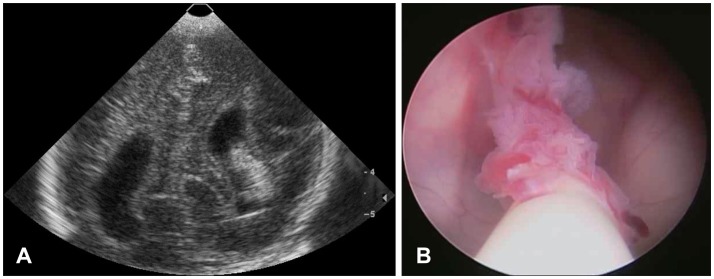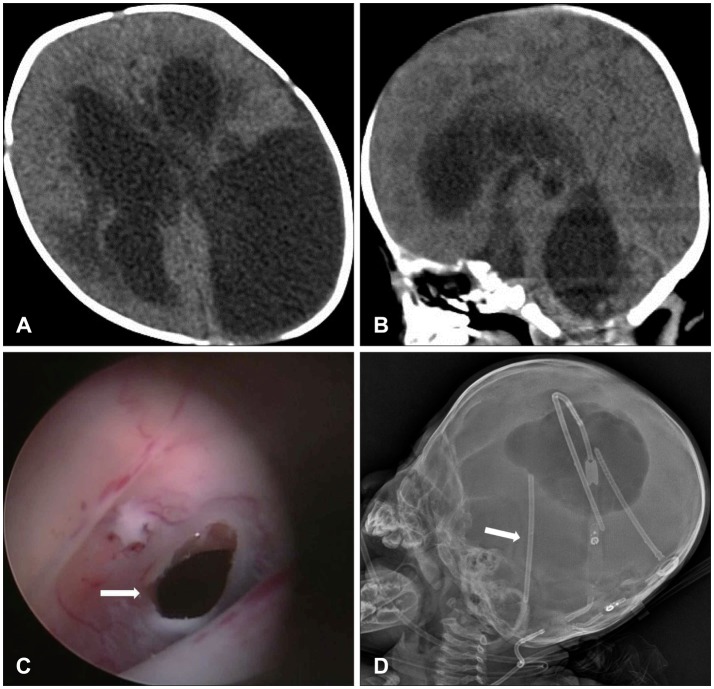1. Ballabh P. Intraventricular hemorrhage in premature infants: mechanism of disease. Pediatr Res. 2010; 67:1–8. PMID:
19816235.

2. Brouwer MJ, de Vries LS, Pistorius L, Rademaker KJ, Groenendaal F, Benders MJ. Ultrasound measurements of the lateral ventricles in neonates: why, how and when? A systematic review. Acta Paediatr. 2010; 99:1298–1306. PMID:
20394588.

3. Cinalli G, Spennato P, Savarese L, Ruggiero C, Aliberti F, Cuomo L, et al. Endoscopic aqueductoplasty and placement of a stent in the cerebral aqueduct in the management of isolated fourth ventricle in children. J Neurosurg. 2006; 104(1 Suppl):21–27. PMID:
16509476.

4. Cornips E, Van Calenbergh F, Plets C, Devlieger H, Casaer P. Use of external drainage for posthemorrhagic hydrocephalus in very low birth weight premature infants. Childs Nerv Syst. 1997; 13:369–374. PMID:
9298272.

5. Duncan CC, Ment LR. Intraventricular hemorrhage and prematurity. Neurosurg Clin N Am. 1993; 4:727–734. PMID:
8241793.

6. Fletcher JM, Landry SH, Bohan TP, Davidson KC, Brookshire BL, Lachar D, et al. Effects of intraventricular hemorrhage and hydrocephalus on the long-term neurobehavioral development of preterm very-low-birthweight infants. Dev Med Child Neurol. 1997; 39:596–606. PMID:
9344052.

7. Folkerth RD. Germinal matrix haemorrhage: destroying the brain's building blocks. Brain. 2011; 134(Pt 5):1261–1263. PMID:
21596767.

8. Hambleton G, Wigglesworth JS. Origin of intraventricular haemorrhage in the preterm infant. Arch Dis Child. 1976; 51:651–659. PMID:
999324.

9. Januschek E, Machado LS, Steinthal B, Ulrich PT. Posthemorrhagic hydrocephalus in very low birth weight infants--a new gentle surgical technique for external ventricular drainage. Childs Nerv Syst. 2011; 27:991–994. PMID:
21399966.

10. Kedzia A. Characteristics of periventricular matrix vascularization in image computer transformation system. Folia Neuropathol. 1995; 33:267–270. PMID:
8673438.
11. Kim SY, Cho JH, Kim KH. Endoscopic coagulation of choroid plexus in hydranencephaly. J Korean Neurosurg Soc. 2014; 55:375–378. PMID:
25237437.

12. Lemons JA, Bauer CR, Oh W, Korones SB, Papile LA, Stoll BJ, et al. Very low birth weight outcomes of the National Institute of Child health and human development neonatal research network, January 1995 through December 1996. NICHD Neonatal Research Network. Pediatrics. 2001; 107:E1. PMID:
11134465.
13. Limbrick DD Jr, Mathur A, Johnston JM, Munro R, Sagar J, Inder T, et al. Neurosurgical treatment of progressive posthemorrhagic ventricular dilation in preterm infants: a 10-year single-institution study. J Neurosurg Pediatr. 2010; 6:224–230. PMID:
20809705.

14. Oi S, Abbott R. Loculated ventricles and isolated compartments in hydrocephalus: their pathophysiology and the efficacy of neuroendoscopic surgery. Neurosurg Clin N Am. 2004; 15:77–87. PMID:
15062406.

15. Papile LA, Burstein J, Burstein R, Koffler H. Incidence and evolution of subependymal and intraventricular hemorrhage: a study of infants with birth weights less than 1,500 gm. J Pediatr. 1978; 92:529–534. PMID:
305471.

16. Peretta P, Ragazzi P, Carlino CF, Gaglini P, Cinalli G. The role of Ommaya reservoir and endoscopic third ventriculostomy in the management of post-hemorrhagic hydrocephalus of prematurity. Childs Nerv Syst. 2007; 23:765–771. PMID:
17226031.

17. Takashima S, Tanaka K. Microangiography and vascular permeability of the subependymal matrix in the premature infant. Can J Neurol Sci. 1978; 5:45–50. PMID:
647497.

18. Vohr B, Allan WC, Scott DT, Katz KH, Schneider KC, Makuch RW, et al. Early-onset intraventricular hemorrhage in preterm neonates: incidence of neurodevelopmental handicap. Semin Perinatol. 1999; 23:212–217. PMID:
10405190.

19. Vohr BR, Allan WC, Westerveld M, Schneider KC, Katz KH, Makuch RW, et al. School-age outcomes of very low birth weight infants in the indomethacin intraventricular hemorrhage prevention trial. Pediatrics. 2003; 111(4 Pt 1):e340–e346. PMID:
12671149.

20. Volpe JJ. Intraventricular hemorrhage in the premature infant--current concepts. Part I. Ann Neurol. 1989; 25:3–11. PMID:
2913926.

21. Whitelaw A, Jary S, Kmita G, Wroblewska J, Musialik-Swietlinska E, Mandera M, et al. Randomized trial of drainage, irrigation and fibrinolytic therapy for premature infants with posthemorrhagic ventricular dilatation: developmental outcome at 2 years. Pediatrics. 2010; 125:e852–e858. PMID:
20211949.

22. Whitelaw A, Thoresen M, Pople I. Posthaemorrhagic ventricular dilatation. Arch Dis Child Fetal Neonatal Ed. 2002; 86:F72–F74. PMID:
11882544.
23. Wu Y, Green NL, Wrensch MR, Zhao S, Gupta N. Ventriculoperitoneal shunt complications in California: 1990 to 2000. Neurosurgery. 2007; 61:557–562. discussion 562-563PMID:
17881969.






 PDF
PDF ePub
ePub Citation
Citation Print
Print




 XML Download
XML Download